SE2 Challenge Team
SE2
Cookbook for MBSE with SysML
ISSUE 1
Name
Date
Signature
�
SE2
Cookbook for MBSE with SysML
/ 1
Page 2
[could not find document date]
�
SE2
Cookbook for MBSE with SysML
/ 1
Page 3
[could not find document date]
Authors
Name
Affiliation
Change Record
Issue
Date
Section /
Paragraph
affected
Reason / Initiation Documents / Remarks
�
SE2
Cookbook for MBSE with SysML
/ 1
Page 4
[could not find document date]
Table of Contents
I. MBSE in Telescope Modelling ................................................................................................. 5
1. Introduction .................................................................................................................... 6
2. Project Description ......................................................................................................... 7
3. MBSE Challenge Goals .................................................................................................. 8
4. Model Structure and Overview ........................................................................................ 9
5. APE Model Structure Pattern ........................................................................................ 10
5.1. Introduction ....................................................................................................... 10
5.2. Overview Diagrams ........................................................................................... 10
5.3. Aspects ............................................................................................................. 12
5.4. Objectives and Requirements ............................................................................. 12
5.5. Context ............................................................................................................. 14
5.6. System Structure ............................................................................................... 16
5.7. Behavior ............................................................................................................ 17
5.8. Data .................................................................................................................. 18
5.9. Verification ........................................................................................................ 20
6. Model Library and Systems-Engineering Profile .............................................................. 21
7. Modeling Challenges .................................................................................................... 22
7.1. Introduction ....................................................................................................... 22
7.2. Notation: Connection of Nested Blocks ............................................................... 22
7.3. Model ................................................................................................................ 23
7.4. Tool .................................................................................................................. 23
7.5. Methodology ...................................................................................................... 23
7.6. Configuration and Quality Control ....................................................................... 24
8. Experiences from a New Project - E-ELT Telescope Control System ............................... 25
9. Conclusions ................................................................................................................. 28
10. References ................................................................................................................. 29
II. Recipes and best Practices .................................................................................................. 30
11. Tool support ............................................................................................................... 31
11.1. Templates for Model Structure .......................................................................... 31
�
SE2 Challenge
Team
Part I. MBSE in Telescope Modelling
�
SE2
Cookbook for MBSE with SysML
/ 1
Page 6
[could not find document date]
Chapter 1. Introduction
In the framework of INCOSE's strategic initiative, the Systems Engineering Vision 2020, one of
the main areas of focus is model-based systems engineering. In keeping with this emphasis, the
European Southern Observatory (ESO; http://www.eso.org/ [ http://www.eso.org/]) is collaborating with
the German Chapter of INCOSE (http://www.gfse.de/) in the form of an "MBSE Challenge" team. The
team's task is to demonstrate solutions to challenging problems using MBSE. The Active Phasing
Experiment (APE; see Gonte et al. 2004), a European Union Framework Program 6 project, was chosen
as the subject of the SE^2 Challenge Team (http://mbse.gfse.de/). Many technical products in the
telescope domain show an increasing integration of mechanics with electronics, information processing,
and also optics, and can therefore be rightly considered as optomechatronic systems.
This article presents the results of model-based systems engineering using the Systems Modeling
Language (SysML; see Ogren 2000), drawing on experiences within the MBSE Challenge project and
also the European Extremely Large Telescope (E-ELT) project. For the former project, SysML models
were created by reverse engineering from existing documentation and from interviews with systems
engineers, whereas for the latter project, the practices were applied to a new system. We will make use of
Ingmar Ogren's concept of a common project model (Ogren 2000) to establish a common understanding
of the system.
�
SE2
Cookbook for MBSE with SysML
/ 1
Page 7
[could not find document date]
Chapter 2. Project Description
Our system case study is the Active Phasing Experiment technology demonstrator for the future
European Extremely Large Telescope, which is a high-tech, interdisciplinary optomechatronic system
in operation at the Paranal observatory (see ESO 2009). The next generation of telescopes needs
to collect significantly more light than older models, therefore requiring bigger reflecting surfaces that
consist of many individual mirror segments. Due to different disturbances (such as vibrations, wind, and
gravity), the segments must be actively controlled to get a continuous mirror surface with a phasing error
of only a few nanometers over the main mirror's diameter of 42 m. The main challenge is to correctly
detect the positioning errors of the segments via specific phasing sensors in order to create a continuous
mirror surface.
APE was developed to evaluate those sensors, and was installed on one of the 8 m telescopes that
constitutes part of the Very Large Telescope in Chile (VLT) for sky tests. APE can be seen as the black
box in Figure 2.1, “Active Phasing Experiment at the Very Large Telescope” . For the installation it had
to comply with various mechanical, electrical, optical, and software interfaces. APE consists of about
two hundred sensors and actuators such as wheels, translation stages, lenses, detectors, mirrors, light
sources, an interferometer, and twelve computing nodes for control. Since APE had to be deployed in
the test lab and in an already existing telescope, for each context it was necessary to model variants
of function, interfaces, and structure. All of these characteristics made APE well suited to evaluate the
potential of SysML in tackling similar issues.
Figure 2.1. Active Phasing Experiment at the Very Large Telescope
�
SE2
Cookbook for MBSE with SysML
/ 1
Page 8
[could not find document date]
Chapter 3. MBSE Challenge Goals
SysML is only a graphical language and defines a set of diagrammatics, modeling elements, a formal
syntax, and semantics. Like any language (formal or informal), it can be used in many different ways,
including many wrong ways. Most notably, it is possible by misusing the language to create incorrect
models. The main goals of the SE^2 MBSE Challenge Team are to
• create modeling guidelines and conventions for all system aspects, hierarchy levels, and views;
• provide examples in SysML, solving common modeling problems;
• build a comprehensive model, which serves as the basis for providing different views to different
engineering aspects and subsequent activities; and to
• demonstrate that SysML is an effective means to support systems engineering.
The SE^2 team has provided their guidelines for modeling on the "frequently asked questions" page
of their Web site (http://mbse.gfse.de/documents/faq.html). A SysML model, as described in the next
section, illustrates the results of their comprehensive modeling. The SysML model is not merely a mental
abstraction, but a collection of complex data structures that can be edited, augmented, queried, and
reported on by means of a suitable tool, which is an indispensible pillar for MBSE.
�
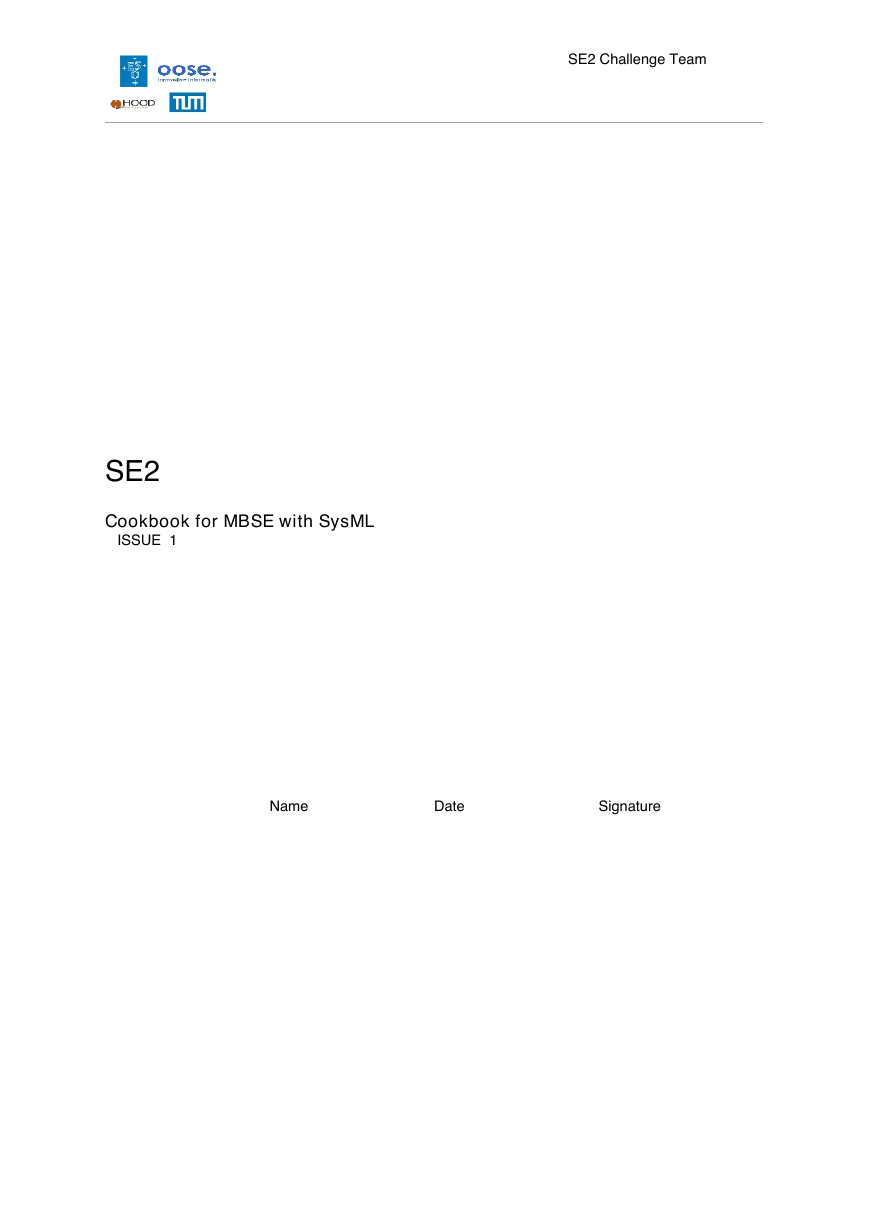


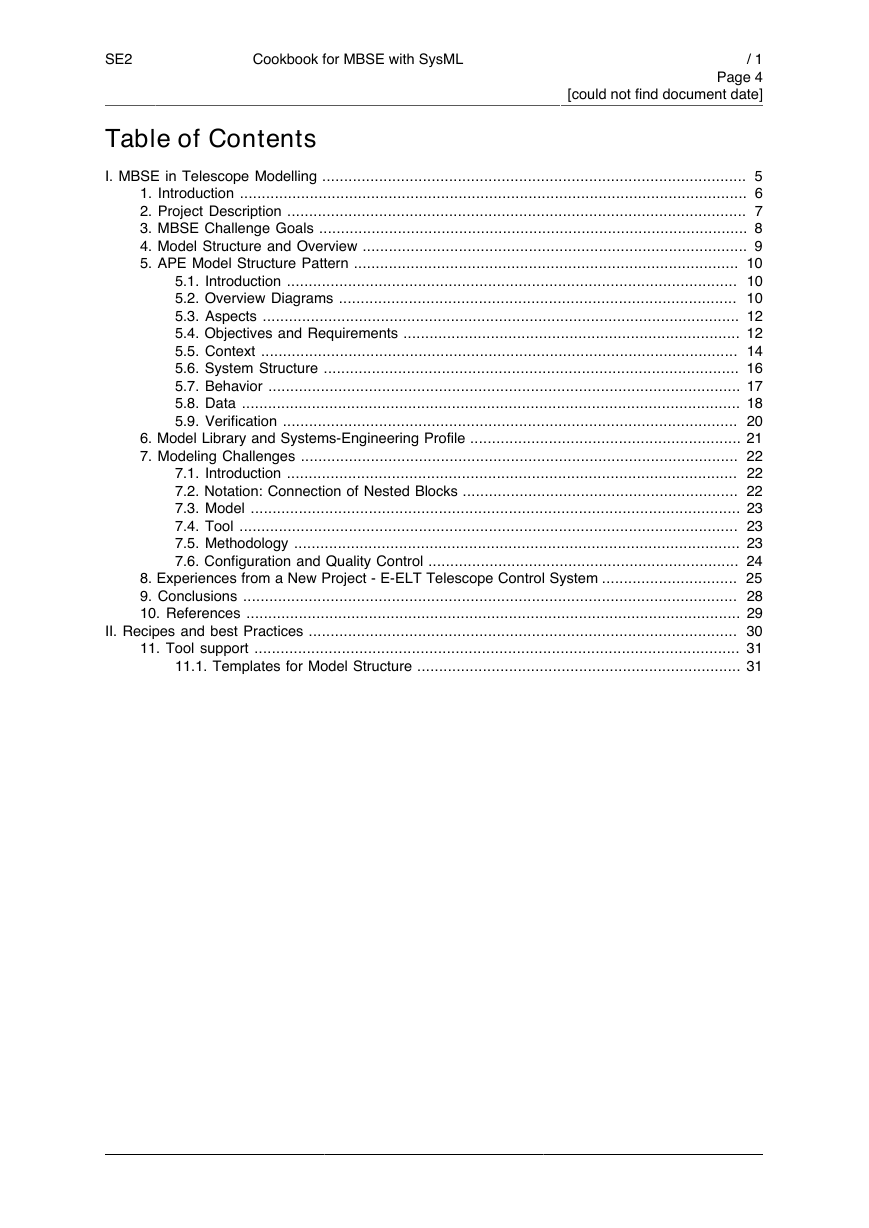
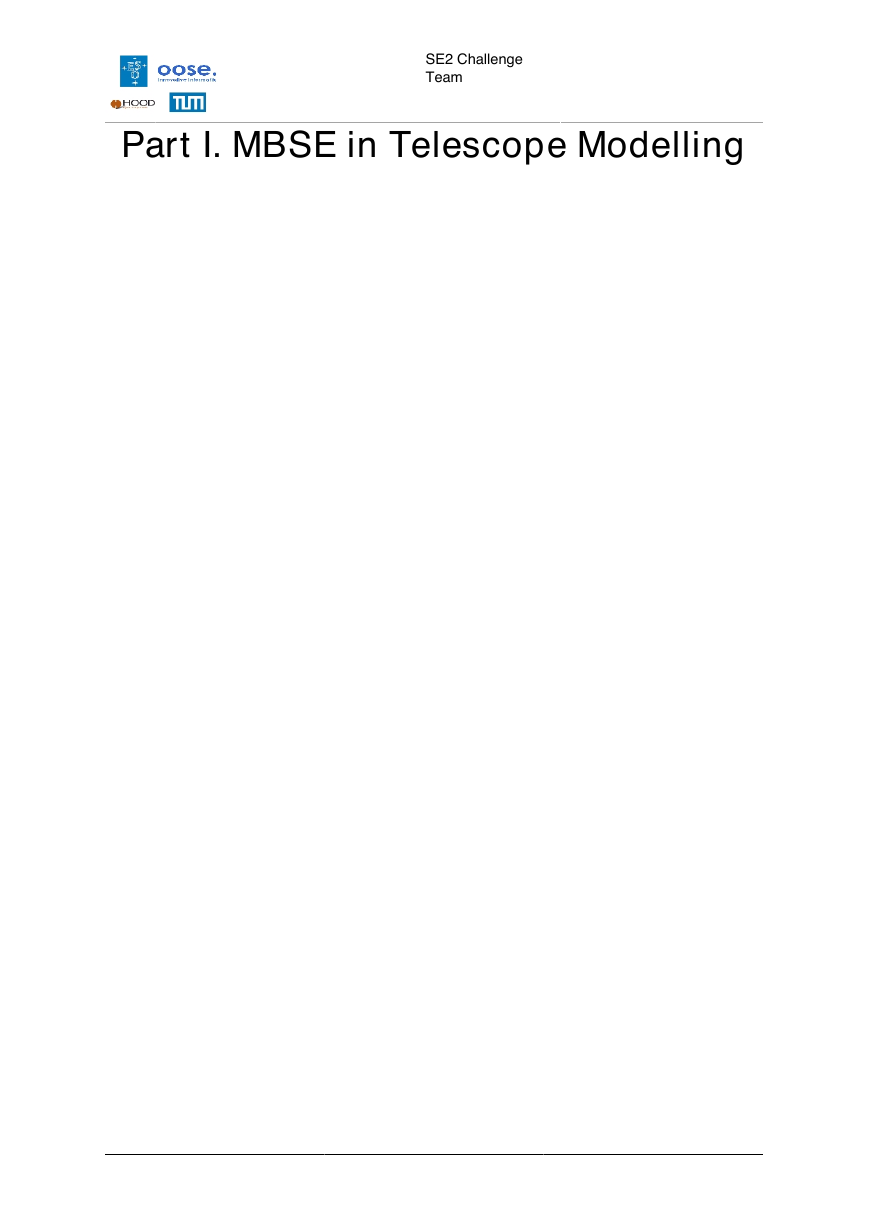
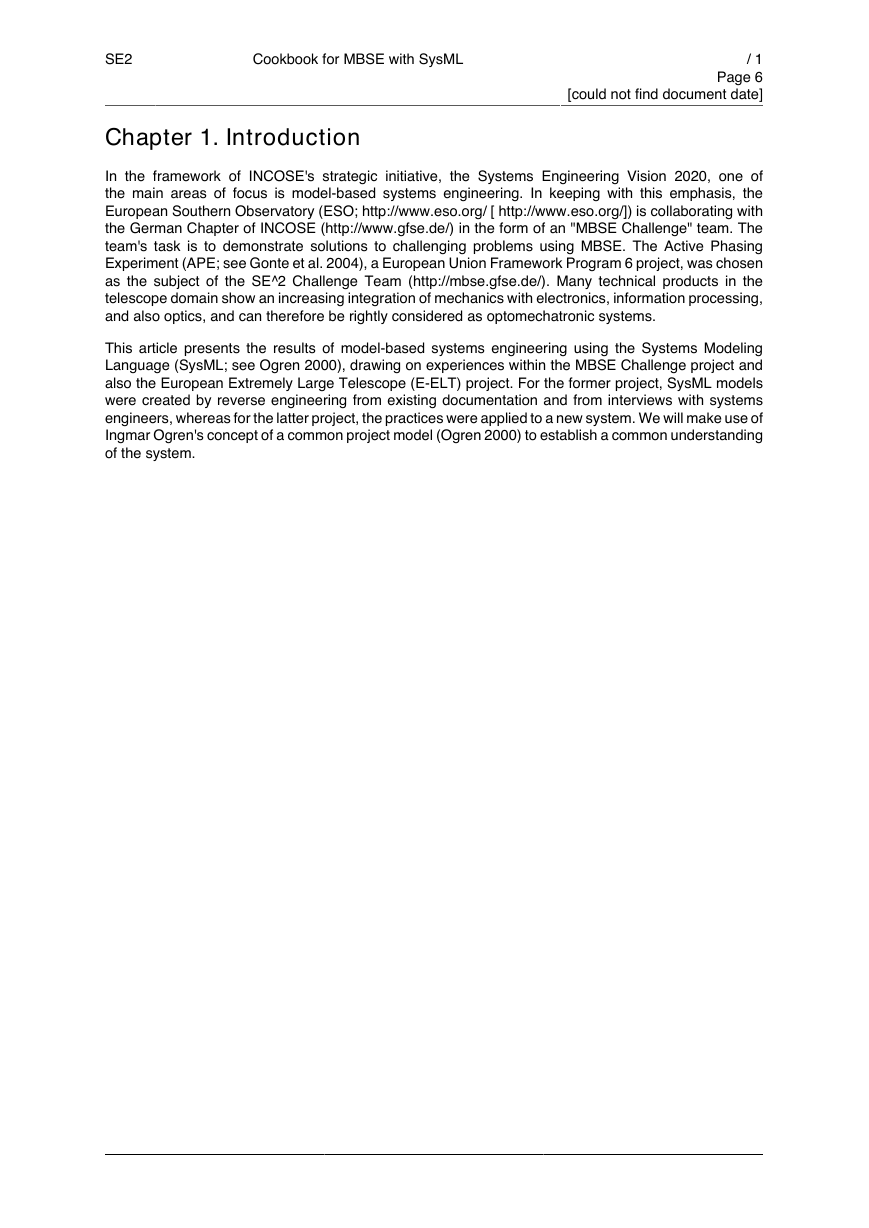
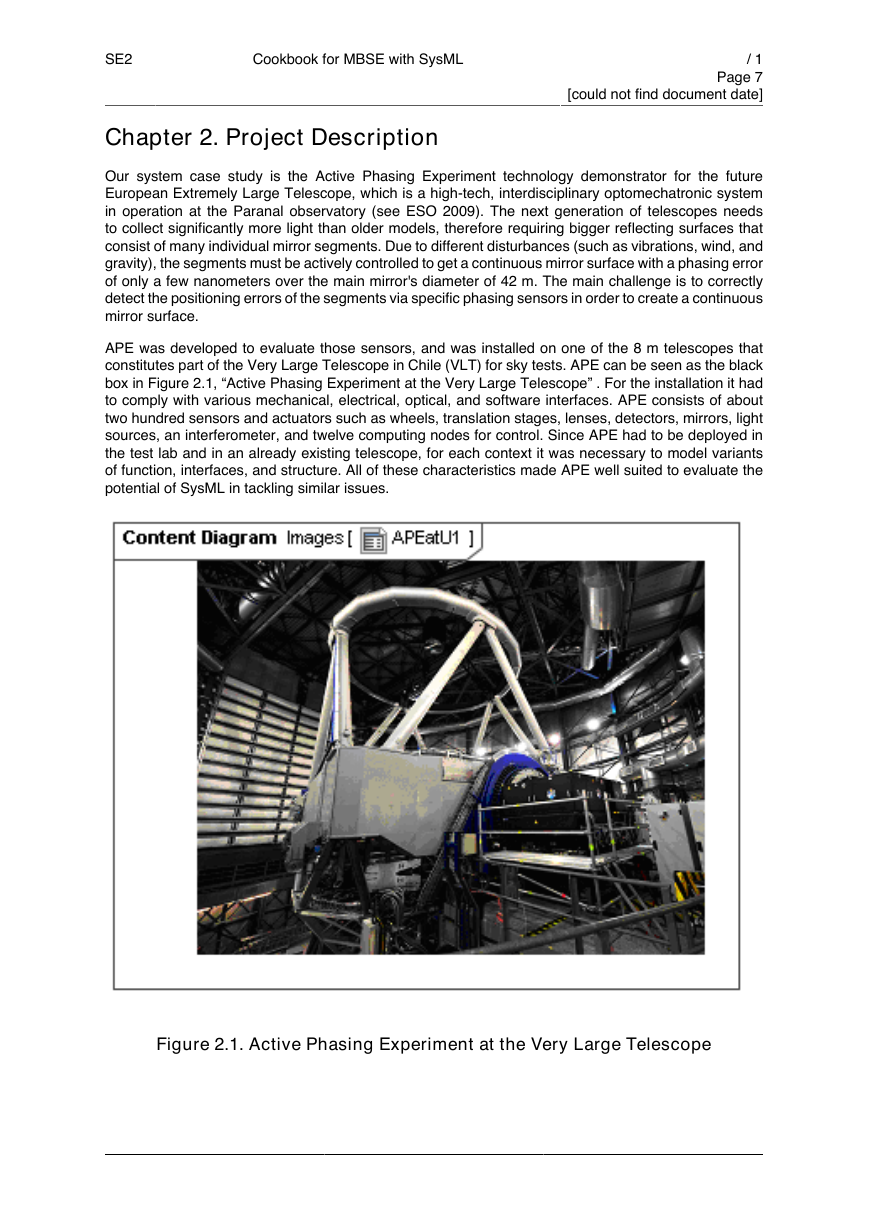









 2023年江西萍乡中考道德与法治真题及答案.doc
2023年江西萍乡中考道德与法治真题及答案.doc 2012年重庆南川中考生物真题及答案.doc
2012年重庆南川中考生物真题及答案.doc 2013年江西师范大学地理学综合及文艺理论基础考研真题.doc
2013年江西师范大学地理学综合及文艺理论基础考研真题.doc 2020年四川甘孜小升初语文真题及答案I卷.doc
2020年四川甘孜小升初语文真题及答案I卷.doc 2020年注册岩土工程师专业基础考试真题及答案.doc
2020年注册岩土工程师专业基础考试真题及答案.doc 2023-2024学年福建省厦门市九年级上学期数学月考试题及答案.doc
2023-2024学年福建省厦门市九年级上学期数学月考试题及答案.doc 2021-2022学年辽宁省沈阳市大东区九年级上学期语文期末试题及答案.doc
2021-2022学年辽宁省沈阳市大东区九年级上学期语文期末试题及答案.doc 2022-2023学年北京东城区初三第一学期物理期末试卷及答案.doc
2022-2023学年北京东城区初三第一学期物理期末试卷及答案.doc 2018上半年江西教师资格初中地理学科知识与教学能力真题及答案.doc
2018上半年江西教师资格初中地理学科知识与教学能力真题及答案.doc 2012年河北国家公务员申论考试真题及答案-省级.doc
2012年河北国家公务员申论考试真题及答案-省级.doc 2020-2021学年江苏省扬州市江都区邵樊片九年级上学期数学第一次质量检测试题及答案.doc
2020-2021学年江苏省扬州市江都区邵樊片九年级上学期数学第一次质量检测试题及答案.doc 2022下半年黑龙江教师资格证中学综合素质真题及答案.doc
2022下半年黑龙江教师资格证中学综合素质真题及答案.doc